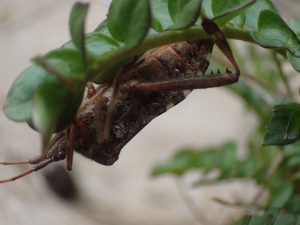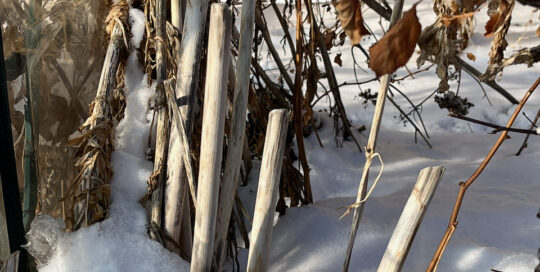Leaf-footed Bugs in the Springtime
Views: 1330

In the spring, insects come out of their hiding spots like wildflowers emerging from their own winter shelter beneath the soil. For many people, stinkbugs and wasps visit them indoors. But leaf-footed bugs are making an appearance in many regions of the country as the weather warms.
We found this little guy while visiting a friend in western Montana when it was perched on the lid of the toilet. My youngest insisted that my eldest remove the unwanted visitor and take it outdoors. While a leaf-footed bug will not bite or hurt you, they have a rather intimidating appearance with an armor-like shield over their inch-long, elongated body, with spiky looking appendages on the hind legs of the males. The hind legs are also somewhat flattened and resemble a leaf.
A case of mistaken identity
These leaf-footed bugs, which are actually Western conifer seed bugs (Leptoglossus occidentalis), resemble squash bugs and are often mistaken as stink bugs. Truthfully, for years I’ve called this variety stink bugs. This is what we initially thought it was when we first spotted it, although when you have one in the house, the specific species probably doesn’t matter so much. Leaf-footed bugs make a loud noise when they fly, and will emit a nasty odor if disturbed. This is particularly true when you crush them, so don’t. Like stink bugs, I recommend scooping them up and taking them outside. If you cannot reach them, use a vacuum to remove them from indoor areas.
Leaf-footed bugs have strong, piercing mouthparts and feed upon the developing cones of western pines and Douglas fir early in the season. At large enough numbers (when they are nymphs) they can do significant damage, but it doesn’t appear to be a problem in most areas. Early in the season, they mate and the females lay eggs on the conifers. These hatch in approximately 10 days, and the nymphs feed upon the trees up until they reach adulthood by August. When the cold weather returns, they migrate towards warm areas, such as your home, and the entire cycle starts over.
Leaf-footed bugs like tomatoes
In our area, leaf-footed bugs are not an issue in the garden. However, in warmer regions, a type of leaf-footed bug is known to head to the ripening tomatoes to feed. There’s nothing more disheartening that having your fresh tomatoes consumed, and leaf-footed bugs can do a considerable amount of damage with their strong, sucking mouthparts. They’ll perch on nearly ripe tomatoes, particularly early in the morning, and feed away.
Handling leaf-footed bugs in the garden
There are a couple of options to reduce their numbers and save your crop. You can pick them off manually and drop the into a bowl of soapy water. Although, I highly recommend wearing gloves in case they release their foul smelling defensive substance. This is particularly because it also causes a skin reaction in some people. The other option is to use a permethrin product. Be sure to read the directions to apply it at the proper time to give you enough time between the application and harvest.
Leaf-footed bugs look intimidating and they shouldn’t be harassed or there might be smelly consequences. Thankfully they don’t bite, don’t hurt much in the garden, and outside of a quick startle on the toilet, are generally harmless.
Meet Amy Grisak
Amy is a freelance author and photographer in Great Falls, MT who specializes in gardening, foods, and sustainable agriculture. She provides information on every kind…
Amy's Recent Posts

This Little Piggy is a Problem: Dealing with Feral Hogs








